Items
In item set
Gezi Images
-
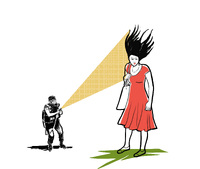 Woman in red illustration
Woman in red illustration -
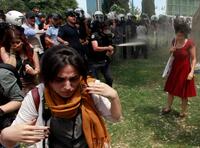 Woman in Red (Ceyda Sungur) The photo was taken during the initial occupation of Gezi Park. Police officer Fatih Zengin is seen attacking a protester with pepper spray. The victim is Ceyda Sungur, an academician at Istanbul Technical University at the time. This photo became one of the most iconic images of Gezi, showing police brutality and riling up people in the early days of the resistance. It won the "Press Photo of the Year" award of the Turkish Photojournalists Association in 2014.
Woman in Red (Ceyda Sungur) The photo was taken during the initial occupation of Gezi Park. Police officer Fatih Zengin is seen attacking a protester with pepper spray. The victim is Ceyda Sungur, an academician at Istanbul Technical University at the time. This photo became one of the most iconic images of Gezi, showing police brutality and riling up people in the early days of the resistance. It won the "Press Photo of the Year" award of the Turkish Photojournalists Association in 2014. -
 Woman in black against a TOMA This picture, taken while a group of people were chanting for the protection of Gezi Park in front of a TOMA (armored water cannon), is another iconic moment of the the resistance. This photo, which has become a representation of the violent approach shown by the police despite the peaceful attitude of the protesters, is a symbol of everyone who resists during the act, as Cullen, the "woman in black", puts it.
Woman in black against a TOMA This picture, taken while a group of people were chanting for the protection of Gezi Park in front of a TOMA (armored water cannon), is another iconic moment of the the resistance. This photo, which has become a representation of the violent approach shown by the police despite the peaceful attitude of the protesters, is a symbol of everyone who resists during the act, as Cullen, the "woman in black", puts it. -
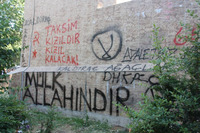 Wall with socialist and religious graffiti The wall is covered with numerous graffiti. One on the left depicts communist symbols and states "Taksim is red, and will remain red!". The sentence is based on the common anti-Islamist chant "Türkiye laiktir laik kalacak!" ("Turkey is laicist, and will remain laicist!"). The other big graffiti on the bottom says "All property belongs to God", on its own a common notion in Islam and other Abrahamic religions. Here it is contextualized against private ownership, supporting the rhetoric of "Anti-capitalist Muslims", a prominent grouping in the Gezi protests.
Wall with socialist and religious graffiti The wall is covered with numerous graffiti. One on the left depicts communist symbols and states "Taksim is red, and will remain red!". The sentence is based on the common anti-Islamist chant "Türkiye laiktir laik kalacak!" ("Turkey is laicist, and will remain laicist!"). The other big graffiti on the bottom says "All property belongs to God", on its own a common notion in Islam and other Abrahamic religions. Here it is contextualized against private ownership, supporting the rhetoric of "Anti-capitalist Muslims", a prominent grouping in the Gezi protests. -
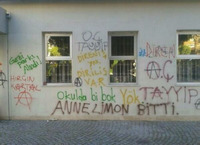 Wall of Graffiti This wall has been sprayed with many graffiti, presumably by multiple people. Two of the graffiti call out "O.Ç Tayyip", "O.Ç" being a common initialism for "child of a bitch" in Turkish and Tayyip being Erdoğan's unpreferred name. The yellow graffiti in the middle says "There's no resistance, only (re-)birth". The brown text in the bottom says "Mom we have no more lemons.", humorously referring to the use of lemons to counter the effects of tear gas. The red graffiti with the anarchy symbols says "aggressive eagle", presumably referring to the mascot of the football team Beşiktaş and its fan group Çarşı.
Wall of Graffiti This wall has been sprayed with many graffiti, presumably by multiple people. Two of the graffiti call out "O.Ç Tayyip", "O.Ç" being a common initialism for "child of a bitch" in Turkish and Tayyip being Erdoğan's unpreferred name. The yellow graffiti in the middle says "There's no resistance, only (re-)birth". The brown text in the bottom says "Mom we have no more lemons.", humorously referring to the use of lemons to counter the effects of tear gas. The red graffiti with the anarchy symbols says "aggressive eagle", presumably referring to the mascot of the football team Beşiktaş and its fan group Çarşı. -
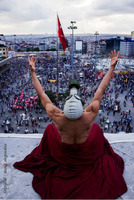 The Whirling Dervish with the Gas Mask The photo shows a person with a semazen (Sufi whirling dervish) costume on top of a structure overlooking Taksim Square. The person is also wearing a gas mask, connecting the traditional and peaceful image of a semazen to the protestors.
The Whirling Dervish with the Gas Mask The photo shows a person with a semazen (Sufi whirling dervish) costume on top of a structure overlooking Taksim Square. The person is also wearing a gas mask, connecting the traditional and peaceful image of a semazen to the protestors. -
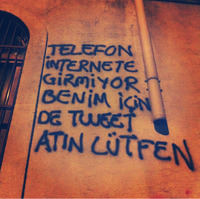 Telefon internete girmiyor benim için de tweet atın lütfen This humorous graffiti shows just how crucial Twitter and social media in general were in the protests.
Telefon internete girmiyor benim için de tweet atın lütfen This humorous graffiti shows just how crucial Twitter and social media in general were in the protests. -
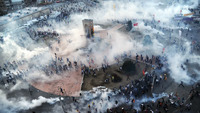 Taksim Square on June 11
Taksim Square on June 11 -
 Sen de gel! The graffiti depicts a semazen (Sufi whirling dervish) with a gas mask. The text says "You come, too!", referencing a famous poem commonly attributed to 13th century Islamic scholar Rumi: Come, come, whoever you are, Wanderer, idolater, worshiper of fire, Come even though you have broken your vows a thousand times, Come, and come yet again. Ours is not a caravan of despair. The poem's attribution is scientifically controversial, but the fact remains that Rumi and Sufism are commonly associated with amnesty and inclusiveness in Turkish culture. The graffiti references these qualities to emphasize the diversity and inclusiveness among the protestors.
Sen de gel! The graffiti depicts a semazen (Sufi whirling dervish) with a gas mask. The text says "You come, too!", referencing a famous poem commonly attributed to 13th century Islamic scholar Rumi: Come, come, whoever you are, Wanderer, idolater, worshiper of fire, Come even though you have broken your vows a thousand times, Come, and come yet again. Ours is not a caravan of despair. The poem's attribution is scientifically controversial, but the fact remains that Rumi and Sufism are commonly associated with amnesty and inclusiveness in Turkish culture. The graffiti references these qualities to emphasize the diversity and inclusiveness among the protestors. -
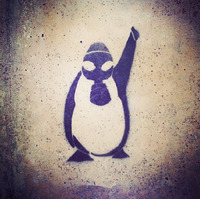 Resisting penguin graffiti
Resisting penguin graffiti -
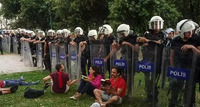 Protesters reading books before police shields Several young adults are sitting next to police shields reading books. They are participating in a silent protest by demonstrating peculiarly peaceful behavior to highlight the police as violent in contrast.
Protesters reading books before police shields Several young adults are sitting next to police shields reading books. They are participating in a silent protest by demonstrating peculiarly peaceful behavior to highlight the police as violent in contrast. -
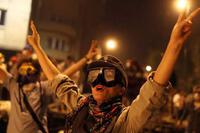 Protesters making victory sign The photo shows two protesters in front of a bigger group. They are wearing gas masks and making the victory sign with both hands.
Protesters making victory sign The photo shows two protesters in front of a bigger group. They are wearing gas masks and making the victory sign with both hands. -
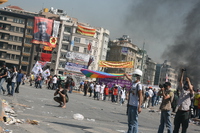 Protesters and various banners on the square The photo shows a large number of protesters in Taksim Square. There are various flags and banners in the background. Some of the more legible ones include: - A banner commemorating İbrahim Kaypakkaya, a former Maoist revolutionary who was hanged in 1973. The text reads "To remember Him is to fight!". - A banner on the right by the "Platform for the Unity of Struggles" saying "Welcome to the Red Square", referring to the Red Square in Moscow and the color red as a symbol of communism. - A big rainbow flag. - A purple banner stating "We don't owe children to anyone, neither to men nor to the state".
Protesters and various banners on the square The photo shows a large number of protesters in Taksim Square. There are various flags and banners in the background. Some of the more legible ones include: - A banner commemorating İbrahim Kaypakkaya, a former Maoist revolutionary who was hanged in 1973. The text reads "To remember Him is to fight!". - A banner on the right by the "Platform for the Unity of Struggles" saying "Welcome to the Red Square", referring to the Red Square in Moscow and the color red as a symbol of communism. - A big rainbow flag. - A purple banner stating "We don't owe children to anyone, neither to men nor to the state". -
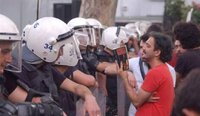 Protester reading a book to police officers A man is standing before a group of police officers forming a human shield, reading a book to them. He is demonstrating a peaceful action to protest the violence from the police.
Protester reading a book to police officers A man is standing before a group of police officers forming a human shield, reading a book to them. He is demonstrating a peaceful action to protest the violence from the police. -
 Posters, banners and flags on the AKM building The photo depicts Atatürk Cultural Center (AKM) during the Gezi protests. The building borders the Taksim Square and stands close to the Gezi Park. Various flags and banners were hung on the building by the public. Some of the more readable ones from left to right, top to bottom include: - Two Çarşı banners (football fan group) - A banner saying "All government will belong to the labor" by "The Struggle Association". The banner features an image of Deniz Gezmiş, an well-known socialist revolutionary who was executed in the 1970s. - A banner crying "Long live revolution and socialism" by "Socialist Democracy Party" - A banner in Kurdish that I unfortunately cannot understand - A banner saying "Long live the unity of workers and the fraternity of peoples" - Flag of the "Socialist Party of the Oppressed" (ESP), a very small Marxist-Leninist party - A banner calling out "Class against class / Revolution against order / Socialism against capitalism" - Two banners calling for a general strike - A banner by the Socialist Refoundation Party stating "Factories, fields, political government, everything will belong to the labor" - A banner by the "Socialist Solidarity Platform" saying "Justice or Apocalypse!" - A big banner by the Socialist Refoundation Party addressed to Erdoğan saying "shut up tayyip!"
Posters, banners and flags on the AKM building The photo depicts Atatürk Cultural Center (AKM) during the Gezi protests. The building borders the Taksim Square and stands close to the Gezi Park. Various flags and banners were hung on the building by the public. Some of the more readable ones from left to right, top to bottom include: - Two Çarşı banners (football fan group) - A banner saying "All government will belong to the labor" by "The Struggle Association". The banner features an image of Deniz Gezmiş, an well-known socialist revolutionary who was executed in the 1970s. - A banner crying "Long live revolution and socialism" by "Socialist Democracy Party" - A banner in Kurdish that I unfortunately cannot understand - A banner saying "Long live the unity of workers and the fraternity of peoples" - Flag of the "Socialist Party of the Oppressed" (ESP), a very small Marxist-Leninist party - A banner calling out "Class against class / Revolution against order / Socialism against capitalism" - Two banners calling for a general strike - A banner by the Socialist Refoundation Party stating "Factories, fields, political government, everything will belong to the labor" - A banner by the "Socialist Solidarity Platform" saying "Justice or Apocalypse!" - A big banner by the Socialist Refoundation Party addressed to Erdoğan saying "shut up tayyip!" -
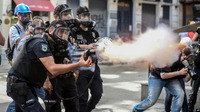 Police firing tear gas Police fire tear gas at demonstrators near Taksim Square.
Police firing tear gas Police fire tear gas at demonstrators near Taksim Square. -
 Person with rainbow flag in front of a queer graffiti The photo depicts a person in colorful clothing, who is holding a rainbow flag. They have a sign on them saying "What is with the ban ayol". "Ayol" is a Turkish filler word usually used by women, but often also by effeminate gay men and other feminine queer people. The graffiti on the wall similarly says "Resist ayol", with the letter "A" depicting the symbol of anarchism.
Person with rainbow flag in front of a queer graffiti The photo depicts a person in colorful clothing, who is holding a rainbow flag. They have a sign on them saying "What is with the ban ayol". "Ayol" is a Turkish filler word usually used by women, but often also by effeminate gay men and other feminine queer people. The graffiti on the wall similarly says "Resist ayol", with the letter "A" depicting the symbol of anarchism. -
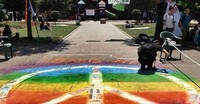 Peace sign on rainbow The photo from Gezi Park shows a white peace sign painted over the colors of the rainbow.
Peace sign on rainbow The photo from Gezi Park shows a white peace sign painted over the colors of the rainbow. -
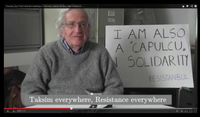 Noam Chomsky salutes the Gezi Park resistance The still is from a video titled "Noam Chomsky salutes the Gezi Park resistance" in Turkish and English. It shows famous linguist and philosopher Noam Chomsky in front of a sign stating "I am also a 'Çapulcu' in solidarity".
Noam Chomsky salutes the Gezi Park resistance The still is from a video titled "Noam Chomsky salutes the Gezi Park resistance" in Turkish and English. It shows famous linguist and philosopher Noam Chomsky in front of a sign stating "I am also a 'Çapulcu' in solidarity". -
 Lambaya püf de This graffiti uses a humorous allegory based on a well-known Turkish song (Barış Manço, Lambaya püf de, 1977). The lightbulb closely resembles the ruling party AKP's logo. In this way, the familiar phrase is turned into a political slogan.
Lambaya püf de This graffiti uses a humorous allegory based on a well-known Turkish song (Barış Manço, Lambaya püf de, 1977). The lightbulb closely resembles the ruling party AKP's logo. In this way, the familiar phrase is turned into a political slogan. -
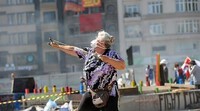 Lady with a sling An older woman is seen wearing a medical mask and using a sling against police forces. The lady, Emine Cansever, was arrested after the protests and remained in police custody for three weeks.
Lady with a sling An older woman is seen wearing a medical mask and using a sling against police forces. The lady, Emine Cansever, was arrested after the protests and remained in police custody for three weeks. -
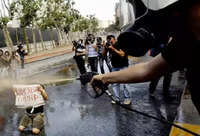 Kimyasal Tayyip A police officer is holding some sort of water pressure device, spraying fluid at a kneeling protester. The protester is holding a sign reading "Chemical Tayyip", referring to Tayyip Erdoğan and the various irritants used (and abused) by the police as riot control agents.
Kimyasal Tayyip A police officer is holding some sort of water pressure device, spraying fluid at a kneeling protester. The protester is holding a sign reading "Chemical Tayyip", referring to Tayyip Erdoğan and the various irritants used (and abused) by the police as riot control agents. -
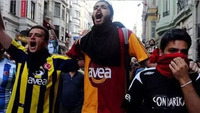 Istanbul United Three men are wearing the jerseys of three rival football teams from Istanbul: Fenerbahçe, Galatasaray and Beşiktaş. They are walking arm in arm as part of a protest.
Istanbul United Three men are wearing the jerseys of three rival football teams from Istanbul: Fenerbahçe, Galatasaray and Beşiktaş. They are walking arm in arm as part of a protest. -
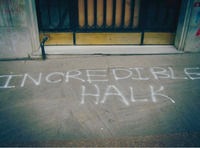 Incredible Halk The graffiti is a wordplay on the Marvel Comics superhero "The Incredible Hulk" and "halk", the Turkish word for "people". It glorifies "the people" behind the uprising by comparing them to the superhumanly abilities of the superhero.
Incredible Halk The graffiti is a wordplay on the Marvel Comics superhero "The Incredible Hulk" and "halk", the Turkish word for "people". It glorifies "the people" behind the uprising by comparing them to the superhumanly abilities of the superhero. -
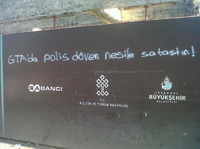 GTA’da polis döven nesile sataştın! This graffiti references the video game series "Grand Theft Auto", a Scottish series which has been extremely popular in Turkey from early 2000s onwards, during the childhood/teens of many young protesters in Gezi. It makes a nostalgic throwback to popular culture to establish a common identity.
GTA’da polis döven nesile sataştın! This graffiti references the video game series "Grand Theft Auto", a Scottish series which has been extremely popular in Turkey from early 2000s onwards, during the childhood/teens of many young protesters in Gezi. It makes a nostalgic throwback to popular culture to establish a common identity.